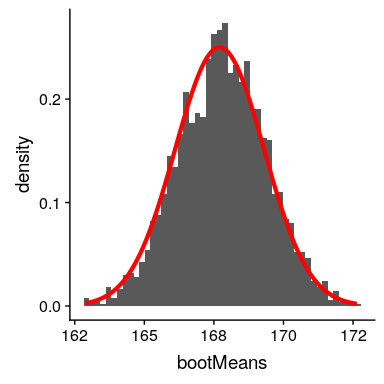## 8.5 使用模擬統計:引導程序
到目前為止,我們已經使用模擬來演示統計原理,但是我們也可以使用模擬來回答實際的統計問題。在本節中,我們將介紹一個稱為 _ 引導程序 _ 的概念,它允許我們使用模擬來量化統計估計的不確定性。在本課程的后面部分,我們將看到模擬通常如何用于回答統計問題的其他示例,特別是當理論統計方法不可用或假設過于令人窒息時。
### 8.5.1 計算引導程序
在上面的章節中,我們利用我們對平均值抽樣分布的了解來計算平均值和置信區間的標準誤差。但是如果我們不能假設這些估計是正態分布的,或者我們不知道它們的分布呢?引導的思想是使用數據本身來估計答案。這個名字來自于用自己的力量把自己拉起來的想法,表達了這樣一個想法:我們沒有任何外部的杠桿來源,所以我們必須依靠數據本身。自舉方法是由斯坦福統計局的布拉德利·埃夫隆構想的,他是世界上最有影響力的統計學家之一。
引導背后的想法是,我們從實際的數據集中重復采樣;重要的是,我們用替換的對 _ 進行采樣,這樣同一個數據點通常會在一個樣本中被多次表示。然后我們計算每個引導樣本的興趣統計,并使用這些估計的分布。_
讓我們從使用引導程序來估計平均值的采樣分布開始,這樣我們就可以將結果與前面討論的平均值的標準誤差(sem)進行比較。
```r
# perform the bootstrap to compute SEM and compare to parametric method
nRuns <- 2500
sampleSize <- 32
heightSample <-
NHANES_adult %>%
sample_n(sampleSize)
bootMeanHeight <- function(df) {
bootSample <- sample_n(df, dim(df)[1], replace = TRUE)
return(mean(bootSample$Height))
}
bootMeans <- replicate(nRuns, bootMeanHeight(heightSample))
SEM_standard <- sd(heightSample$Height) / sqrt(sampleSize)
sprintf("SEM computed using sample SD: %f", SEM_standard)
```
```r
## [1] "SEM computed using sample SD: 1.595789"
```
```r
SEM_bootstrap <- sd(bootMeans)
sprintf("SEM computed using SD of bootstrap estimates: %f", SEM_bootstrap)
```
```r
## [1] "SEM computed using SD of bootstrap estimates: 1.586913"
```

圖 8.4 計算平均值標準誤差的引導示例。柱狀圖顯示平均值在引導樣本之間的分布,紅線顯示基于樣本平均值和標準差的正態分布。
圖[8.4](#fig:bootstrapSEM)顯示,基于正態性假設,引導樣本的平均值分布與理論估計值相當接近。我們也可以使用引導樣本計算平均值的置信區間,只需從引導樣本的分布計算感興趣的分位數。
```r
# compute bootstrap confidence interval
bootCI <- quantile(bootMeans, c(0.025, 0.975))
pander("bootstrap confidence limits:")
```
自舉置信限:
```r
pander(bootCI)
```
<colgroup><col style="width: 13%"> <col style="width: 13%"></colgroup>
| 2.5% | 98% |
| --- | --- |
| 164.634 年 | 170.883 個 |
```r
# now let's compute the confidence intervals using the sample mean and SD
sampleMean <- mean(heightSample$Height)
normalCI <-
tibble(
"2.5%" = sampleMean - 1.96 * SEM_standard,
"97.5%" = sampleMean + 1.96 * SEM_standard
)
print("confidence limits based on sample SD and normal distribution:")
```
```r
## [1] "confidence limits based on sample SD and normal distribution:"
```
```r
pander(normalCI)
```
<colgroup><col style="width: 13%"> <col style="width: 13%"></colgroup>
| 2.5% | 97.5% |
| --- | --- |
| 164.575 年 | 170.831 個 |
我們通常不會使用引導程序來計算平均值的置信區間(因為我們通常可以假設正態分布適合平均值的抽樣分布,只要我們的樣本足夠大),但是這個例子顯示了該方法如何粗略地給出結果與基于正態分布的標準方法相同。在我們知道或懷疑正態分布不合適的情況下,引導程序更常被用來為其他統計數據的估計生成標準錯誤。
- 前言
- 0.1 本書為什么存在?
- 0.2 你不是統計學家-我們為什么要聽你的?
- 0.3 為什么是 R?
- 0.4 數據的黃金時代
- 0.5 開源書籍
- 0.6 確認
- 1 引言
- 1.1 什么是統計思維?
- 1.2 統計數據能為我們做什么?
- 1.3 統計學的基本概念
- 1.4 因果關系與統計
- 1.5 閱讀建議
- 2 處理數據
- 2.1 什么是數據?
- 2.2 測量尺度
- 2.3 什么是良好的測量?
- 2.4 閱讀建議
- 3 概率
- 3.1 什么是概率?
- 3.2 我們如何確定概率?
- 3.3 概率分布
- 3.4 條件概率
- 3.5 根據數據計算條件概率
- 3.6 獨立性
- 3.7 逆轉條件概率:貝葉斯規則
- 3.8 數據學習
- 3.9 優勢比
- 3.10 概率是什么意思?
- 3.11 閱讀建議
- 4 匯總數據
- 4.1 為什么要總結數據?
- 4.2 使用表格匯總數據
- 4.3 分布的理想化表示
- 4.4 閱讀建議
- 5 將模型擬合到數據
- 5.1 什么是模型?
- 5.2 統計建模:示例
- 5.3 什么使模型“良好”?
- 5.4 模型是否太好?
- 5.5 最簡單的模型:平均值
- 5.6 模式
- 5.7 變異性:平均值與數據的擬合程度如何?
- 5.8 使用模擬了解統計數據
- 5.9 Z 分數
- 6 數據可視化
- 6.1 數據可視化如何拯救生命
- 6.2 繪圖解剖
- 6.3 使用 ggplot 在 R 中繪制
- 6.4 良好可視化原則
- 6.5 最大化數據/墨水比
- 6.6 避免圖表垃圾
- 6.7 避免數據失真
- 6.8 謊言因素
- 6.9 記住人的局限性
- 6.10 其他因素的修正
- 6.11 建議閱讀和視頻
- 7 取樣
- 7.1 我們如何取樣?
- 7.2 采樣誤差
- 7.3 平均值的標準誤差
- 7.4 中心極限定理
- 7.5 置信區間
- 7.6 閱讀建議
- 8 重新采樣和模擬
- 8.1 蒙特卡羅模擬
- 8.2 統計的隨機性
- 8.3 生成隨機數
- 8.4 使用蒙特卡羅模擬
- 8.5 使用模擬統計:引導程序
- 8.6 閱讀建議
- 9 假設檢驗
- 9.1 無效假設統計檢驗(NHST)
- 9.2 無效假設統計檢驗:一個例子
- 9.3 無效假設檢驗過程
- 9.4 現代環境下的 NHST:多重測試
- 9.5 閱讀建議
- 10 置信區間、效應大小和統計功率
- 10.1 置信區間
- 10.2 效果大小
- 10.3 統計能力
- 10.4 閱讀建議
- 11 貝葉斯統計
- 11.1 生成模型
- 11.2 貝葉斯定理與逆推理
- 11.3 進行貝葉斯估計
- 11.4 估計后驗分布
- 11.5 選擇優先權
- 11.6 貝葉斯假設檢驗
- 11.7 閱讀建議
- 12 分類關系建模
- 12.1 示例:糖果顏色
- 12.2 皮爾遜卡方檢驗
- 12.3 應急表及雙向試驗
- 12.4 標準化殘差
- 12.5 優勢比
- 12.6 貝葉斯系數
- 12.7 超出 2 x 2 表的分類分析
- 12.8 注意辛普森悖論
- 13 建模持續關系
- 13.1 一個例子:仇恨犯罪和收入不平等
- 13.2 收入不平等是否與仇恨犯罪有關?
- 13.3 協方差和相關性
- 13.4 相關性和因果關系
- 13.5 閱讀建議
- 14 一般線性模型
- 14.1 線性回歸
- 14.2 安裝更復雜的模型
- 14.3 變量之間的相互作用
- 14.4“預測”的真正含義是什么?
- 14.5 閱讀建議
- 15 比較方法
- 15.1 學生 T 考試
- 15.2 t 檢驗作為線性模型
- 15.3 平均差的貝葉斯因子
- 15.4 配對 t 檢驗
- 15.5 比較兩種以上的方法
- 16 統計建模過程:一個實例
- 16.1 統計建模過程
- 17 做重復性研究
- 17.1 我們認為科學應該如何運作
- 17.2 科學(有時)是如何工作的
- 17.3 科學中的再現性危機
- 17.4 有問題的研究實踐
- 17.5 進行重復性研究
- 17.6 進行重復性數據分析
- 17.7 結論:提高科學水平
- 17.8 閱讀建議
- References
